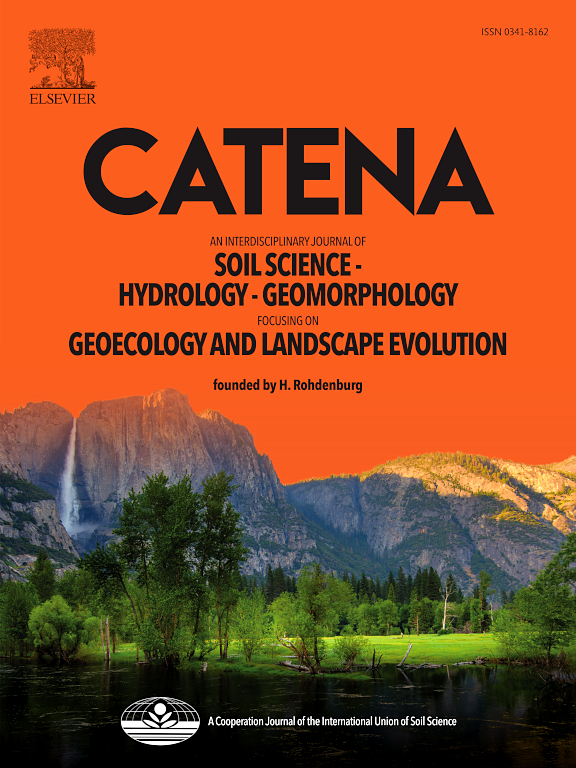中国中原地区晚全新世植被演替与气候变化:来自高分辨率花粉记录的证据
IF 5.4
1区 农林科学
Q1 GEOSCIENCES, MULTIDISCIPLINARY
引用次数: 0
摘要
东亚夏季风降水的变化将对中国的政治、经济和社会发展产生重大影响。为了探讨中国中原地区晚全新世(~ 3350 ~ 2560 cal.yr . BP)植被演替和东亚夏季风降水变化的控制因素和驱动因素,我们对郑州浦田岩心进行了花粉分析。结果表明,植被和东亚夏季风的变化有3个时期:在~ 3350 ~ 3025 cal. yr. BP之间,针叶阔叶混交林增加;在~ 3025 ~ 2930 cal. yr. BP之间,以阔叶桦树为主的森林植被增加;在~ 2930 ~ 2560 cal. yr. BP之间,以蒿科和禾科为主的森林植被减少,草本植物增加。采用加权平均偏最小二乘回归定量重建了中国中原地区年平均降水变化。我们的降水重建及其与其他重建和强迫的比较表明,它受到内部(热带辐合带和El Niño-Southern振荡)和外部(北半球夏季日照)强迫的影响。具体来说,年平均降水量在~ 2980 ~ 2680 cal. yr. BP之间显著减少,树木花粉(如桦树)在此期间也显著减少,这可能与“2.8 ka”事件(全新世的弱季风事件)有关。对比已发表的东亚季风区气候环境记录,认为2.8 ka事件表现为“干-湿-干”的“W”型结构,可能是太阳活动减弱引起的,太阳活动减弱通过El Niño-Southern涛动等海洋和陆地大气环流影响了东亚季风区气候。本文章由计算机程序翻译,如有差异,请以英文原文为准。
Late holocene vegetation succession and climate change in the Central Plains of China: Evidence from a high-resolution pollen record
Changes in the East Asian summer monsoon precipitation will have a significant impact on China’s politics, economy, and social development. To explore the controls and drivers of the Late Holocene (∼3350–2560 cal. yr. BP) vegetation succession and East Asian summer monsoon precipitation changes in the Central Plains of China, we conducted pollen analysis of the Pu Tian core collected from Zhengzhou, China. The results showed three periods of vegetation and East Asian summer monsoon variation: coniferous and broad-leaved mixed forest between ∼3350–3025 cal. yr. BP, increasing forest vegetation dominated by broadleaf Betula between ∼3025–2930 cal. yr. BP, decreasing forest vegetation and increasing herbaceous plants dominated by Artemisia and Poaceae between ∼2930–2560 cal. yr. BP. Weighted Averaging Partial Least Squares Regression was used to quantitatively reconstruct the average annual precipitation variation in the Central Plains of China. Our precipitation reconstruction and its comparison to other reconstructions and forcing show that it was influenced by internal (intertropical convergence zone and El Niño-Southern Oscillation) and external (Northern Hemisphere Summer Insolation) forcing. Specifically, average annual precipitation decreased significantly between ∼2980–2680 cal. yr. BP, and tree pollen (such as Betula) also decreased significantly during this period, possibly related to the “2.8 ka” event (a weak monsoon event in the Holocene). Our comparison of the published climate and environmental records of the East Asian monsoon region suggests that the 2.8 ka event exhibiting a “W” structure of “dry-wet-dry” and may have been caused by the weakening of solar activity, which affected the climate of the East Asian monsoon region through oceanic and terrestrial atmospheric circulation such as El Niño-Southern Oscillation.
求助全文
通过发布文献求助,成功后即可免费获取论文全文。
去求助
来源期刊

Catena
环境科学-地球科学综合
CiteScore
10.50
自引率
9.70%
发文量
816
审稿时长
54 days
期刊介绍:
Catena publishes papers describing original field and laboratory investigations and reviews on geoecology and landscape evolution with emphasis on interdisciplinary aspects of soil science, hydrology and geomorphology. It aims to disseminate new knowledge and foster better understanding of the physical environment, of evolutionary sequences that have resulted in past and current landscapes, and of the natural processes that are likely to determine the fate of our terrestrial environment.
Papers within any one of the above topics are welcome provided they are of sufficiently wide interest and relevance.
 求助内容:
求助内容: 应助结果提醒方式:
应助结果提醒方式:


